大学英语系英语教材《语音教程 1》Unit 13
- 格式:ppt
- 大小:3.69 MB
- 文档页数:4
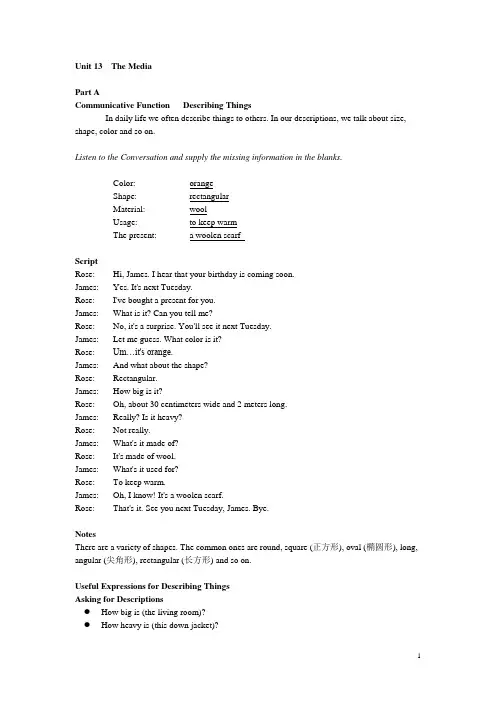
Unit 13 The MediaPart ACommunicative Function Describing ThingsIn daily life we often describe things to others. In our descriptions, we talk about size, shape, color and so on.Listen to the Conversation and supply the missing information in the blanks.Color: orangeShape: rectangularMaterial: woolUsage: to keep warmThe present: a woolen scarfScriptRose: Hi, James. I hear that your birthday is coming soon.James: Yes. It's next Tuesday.Rose: I've bought a present for you.James: What is it? Can you tell me?Rose: No, it's a surprise. You'll see it next Tuesday.James: Let me guess. What color is it?Rose: Um…it's orange.James: And what about the shape?Rose: Rectangular.James: How big is it?Rose: Oh, about 30 centimeters wide and 2 meters long.James: Really? Is it heavy?Rose: Not really.James: What's it made of?Rose: It's made of wool.James: What's it used for?Rose: To keep warm.James: Oh, I know! It's a woolen scarf.Rose: That's it. See you next Tuesday, James. Bye.NotesThere are a variety of shapes. The common ones are round, square (正方形), oval (橢圆形), long, angular (尖角形), rectangular (长方形) and so on.Useful Expressions for Describing ThingsAsking for Descriptions●How big is (the living room)?●How heavy is (this down jacket)?●How does (the computer) work?●What's (the shopping bag) made of?●What's (this tool) used for?●What color are (the walls)?●What size are (the shoes)?●What does (your new apartment) look like?●Can you describe (the house/flat you have just moved in)?●Tell me about (the kitchen).Describing Things●It's (dark blue).●It's (round).●It's made of (wood/plastic/leather).●It's (quite long and rather wide).●It's (a multi-storey building).●It's (in the center of the town).●It’s (quite modern).●It looks like (a TV set).Listening Strategy Filling in FormsIn everyday life we often have to fill in different kinds of forms. Knowing how to fill in a form is a skill we must learn. Before filling in a form it is important to find out what kind of information is required and where to write the relevant details.Now listen to the tape and then complete the student information card and the hotel reservation form below.ScriptBetty Li graduated from No.3 Girls High School in Shanghai in the summer of 2008. She enrolled in the Department of Chinese at Northwest University on August 31st, 2008. Betty lives on campus. She lives in Room 420 of No.1 Residence Hall for students. Her phone number is 52167739.Betty was born on August 19th, 1990. She is interested in writing, painting and music. She hopes to become a writer when she finishes college.Part BPre-listening TaskQuestions for DiscussionYou are going to talk about the media. Read the following questions and discuss them with your partner.1.Do you often listen to the radio?2.What kind of radio programs do you listen to? What do you think of them?3.Do you often watch TV?4.What TV programs do you like watching?5.Which do you like better, radio or television? Why?6.What role do radio and TV play in your life?7.Can you imagine a life without TV or radio?Demo4. What TV programs do you like watching?I like watching travel programs and Discovering Channel. For example, travel programs introduce to the audience the unknown land with peculiar culture or customs of the native people. So the audience, without going out of doors, can experience the beautiful scenery and the fantastic customs. I have to admit that I'm a big fan of Discovery Channel which shows the recent development or findings in science and technology. I can still remember one issue of the program about the Mood Landing. It's really fascinating. I think Discovery Channel does produce some of the best documentaries in the world.6. What role do radio and TV play in your life?TV and radio are an integral part of my life. I don't read newspapers and I rely heavily on radio or TV to keep me informed. I watch the news on TV every evening or listen to the news while having a dinner. What's more, the radio and television present various kinds of programs. They present programs of sports and entertainment. We can enjoy listening to different forms of music and songs on the radio and watch the live broadcast of sports events and the reports of adventures in the mountains and unknown lands. Educational programs of different kinds are presented on the radio and television as well. These programs are very informative. There are lectures and discussions on the latest science and arts subjects.Language FocusHere are some sentences and structures that you might find handy in discussing the above questions:●Radio and TV connect us to the outside world / tell us what is happening near and far /shortens the distance between us and the outside world.●I listen to news / English news / music / story-telling / sports / talk of the day / economicnews on the radio while I'm getting up / having breakfast / on my way to class / before I go to bed ….●I like to leave my radio on while I'm reading / working on my homework / waiting for a bus /riding on a train …●I enjoy listening to / watching …program most. I think it's terrific / fascinating / moving /funny / informative / instructive / amus ing / relaxing / entertaining / romantic …●I like small portable radios. You can carry one with you wherever you go.●Many people catch the latest news on their car radio.●I often watch sports / discovery channel programs / travel programs / talk shows / quiz shows/ soap operas / variety shows on TV.●I prefer TV to radio. TV is visual / not only tells you what is happening but also lets you seeit with your own eyes / brings the outside world right into your room.●One picture is worth a thousand words.●Compared with radio, everything on television is more lifelike, vivid and real.●Television takes up too much of our time. We no longer have enough time to develop otherinterests.●Life without TV or radio is possible today ’cause we’ve got the Internet, wh ich presents us amore colorful world.●I think turning off TV one night or two a week is a good thing/ will give us more time to bewith our family or friends.Listening TasksA PassageRadio and TVWord Bankadapt v. to adjust 适应imaginative a. using or having imagination富有想象力的visual a. gained by seeing, visible视觉的,看得见的flexible a. adaptable 灵活的,适应性强的portable a. movable; quite small and light便携的,手提式的jog v. to run slowly and steadily 慢跑access n. means of obtaining 取得……的途径interval n. a period of time between events, activities, etc. 间隔interactive a. influencing or having an effect on each other交互的,互动的ScriptRadio and TVThe most obvious difference between radio and television is that you listen and look at the television, but just listen to the radio. In this way, radio is more imaginative because it forces you to form pictures in your own mind rather than providing you with visual information, which is what television does.In addition, radio is more flexible than television, since you don't have to be in the same room as the radio set in order to listen to the programs, but you do have to be in the same room as a television in order to watch it.A radio is also far more portable than a television. You can listen to the radio while driving in the car, jogging or even just walking around. Although portable televisions do exist, you can't really watch one while you are jogging, for example.One of the main advantages of radio, however, is that it offers the listener more immediate access to information. Most radio stations broadcast news reports at regular half-hour or hourly intervals, but television news is only broadcast a few times each day. Also, the variety of topics you get on the radio is much greater than that on television.Radio is more personal than television. Many radio programs are interactive in a way that television can never be. Listeners can call the radio station they are listening to and express their thoughts and opinions live on air. You can't ring up a television station and express your opinions, can you?Language and Culture Notes1.Background information From its appearance at the beginning of the 20th century, radio had been a major provider of news and entertainment until television came into being. The early models of the modern television appeared in the 1920s but its popularity did not begin until after World War II, especially until after color TV became available in the 1960s. Today TV sets are much more sophisticated. Not only are they attached with remote control, but they can be hooked to VCR, VCD, DVD and even to the Internet. So it is not surprising that more and more people now watch TV to get news, sports, and a great variety of entertainment. Yet television cannot completely replace radio. Many people still like radio because of its compactness in size. Radio also survives as a major part of a tape recorder, a hi-fi and a necessary component of a car. To adapt to the invention of TV, radio has also made great changes in its system, and in the way it presents programs. The stereo system, for example, is successful in winning music lovers to radio programs.2. portable television A television set about 3" in size and can easily be carried or moved3. at regular half-hour or hourly intervals(the program is broadcast on the radio) every half hour or every hour4. Many radio programs are interactive …Program hosts or hostesses can get immediate feedback from their listeners and they can discuss a topic on the air. With TV, however, audience interaction is more difficult. The usual way is to send out a TV crew to bring in live coverage of people's response to some event.5.live on air Listeners' thoughts or opinions can be heard on the radio at the moment they are spoken rather than later on a recording.Exercise 1: Listening for general understandingListen to the recording once and choose the right answers to the questions you hear.1. What is the passage mainly about?a. The advantages of radio over television.b. The difference between radio and television.c. The changes made to radio programs.d. The reasons for the unpopularity of TV programs.2. Which of the following reflects the speaker's attitude?a. The invention of television is a failure.b. The invention of television has had a great impact on radio.c. Radio definitely has a larger audience than television does.d. Radio will not easily be replaced by television.Exercise 2: Listening for detailsListen to the recording once again and fill in the chart with the missing information.Speaking TasksPair WorkListen to the conversations and repeat after the recording. Practise the conversations with your partner, playing the role of A or B. Then work with your partner to create your own conversations by replacing the underlined parts with your own words.Part CAdditional ListeningA Passage The Benson Family’s DecisionA. Listen to the passage and answer the following question.What’s the main idea of the passage?Without watching TV, people may find many interesting things to do.B. Listen to the passage again and choose the best answers.What has each member of the Benson Family found time doing in the past year?1. Mr. Benson a. playing the pianob. playing tennisc. working in the cinemad. writing a novel2. Mrs. Benson a. taking up judob. seeing films and playsc. writing a dramad. joining a film society3. Daughter Emily a. taking up actingb. reading ten novelsc. learning to play the pianod. solving math problems4. Son Mark a. reading novels and other booksb. playing tennisc. joining a societyd. going to tennis classesScriptThe Benson Family’s DecisionHave you ever spent a year without television? A year ago the Benson family decided that they were spending too much time in front of the box. So they got rid of it. And they have been living without a television for almost a year now. How have they been spending their free time then?“We found it very hard for the first few weeks,” says Mrs. Benson. “We didn’t k now what to do with our free time. But since then it’s been fine. We’ve done so many things that we hadn’t done for such a long time. Last year, for example, we didn’t go out to the cinema or the theatre once, but this year we’ve seen at least a dozen films and plays. And I’ve even joined the local drama society.Mr. Benson has taken up tennis. Daughter Emily has been learning to play the piano and son Mark has been going to judo (柔道) classes. And they’ve all read more books. Mark said, “This year I’ve read about ten novels and five or six other books, too.”So haven’t they missed the box at all? Emily says she has had a few problems: “I don’t like it when I go to school and all the kids are talking about a program that they’ve seen. Actually, I’ve just bee n watching a program at my friend’s house.”Nevertheless, according to Mr. Benson, “We’ve all started doing so many interesting thingsthat we wouldn’t have time to watch TV now.”Part DTest Your ListeningA Compound DictationListen to the passage three times and supply the missing information.There are different 1) types of media today. News and 2) entertainmentare communicated to us in a number of different ways, using different media. It may be 3) print media such as newspapers and magazines, or 4) electronic media such as radio and television. The word media is most often used to refer to the communication of news, and in this 5) context means the same as news media.Programs on radio and television may be referred to formally as 6) broadcasts or informally as shows, especially in American English. The person who 7) presents a program or a show on radio or TV is a host or hostess but the one who hosts a popular music program is called a disk jockey or DJ. 8) News programs may be hosted by an anchor, either a man or a woman, who is sometimes more famous than the people in the news. In more traditional news programs, the news is read by a newsreader.There are many broadcasting organizations in a country and competition among them is serious. 9) Most TV and radio networks want to increase the size of their audience, or their ratings. Good ratings are especially important during prime-time, the time of day when most people watch TV. This is not surprising as high audience figures attract more advertising or commercials to be shown in commercial breaks between programs. And 10) the broadcasting organization that can attract most advertising makes most money.。
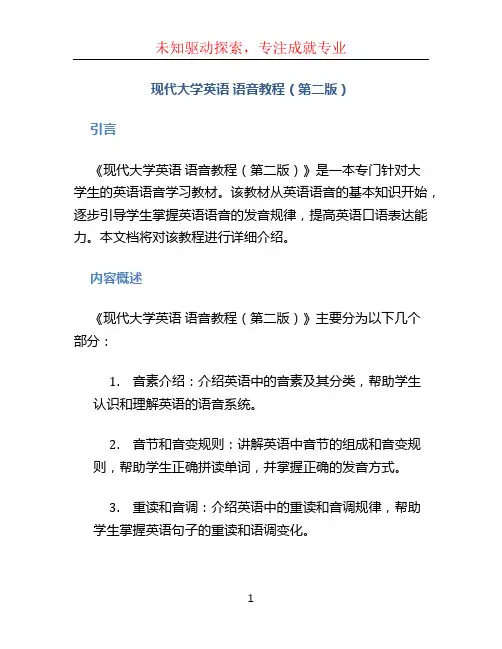
现代大学英语语音教程(第二版)引言《现代大学英语语音教程(第二版)》是一本专门针对大学生的英语语音学习教材。
该教材从英语语音的基本知识开始,逐步引导学生掌握英语语音的发音规律,提高英语口语表达能力。
本文档将对该教程进行详细介绍。
内容概述《现代大学英语语音教程(第二版)》主要分为以下几个部分:1.音素介绍:介绍英语中的音素及其分类,帮助学生认识和理解英语的语音系统。
2.音节和音变规则:讲解英语中音节的组成和音变规则,帮助学生正确拼读单词,并掌握正确的发音方式。
3.重读和音调:介绍英语中的重读和音调规律,帮助学生掌握英语句子的重读和语调变化。
4.连读和语音规则:讲解英语中的连读和语音规则,帮助学生在口语表达中流畅地连接词汇和句子。
5.声调和语流:介绍英语中的声调和语流规律,帮助学生提高口语的自然度和流利度。
6.习题和练习:提供丰富的习题和练习,帮助学生巩固所学的语音知识和技巧。
教材特点1.系统性:该教材按照语音学的知识点进行组织,层层递进,帮助学生循序渐进地学习语音知识。
2.实用性:教材中的例子多样且贴近生活,帮助学生将语音知识应用于实际交流中。
3.练习丰富:教材提供了大量的习题和练习,帮助学生巩固所学的语音知识和技巧。
4.听力训练:教材中配有丰富的听力材料,帮助学生培养对英语语音的听辨和理解能力。
学习建议学生在使用《现代大学英语语音教程(第二版)》时,可以参考以下学习建议:1.充分利用教材中的例子和练习,积极参与口语练习,提高口语表达能力。
2.多听多读多练习,通过大量的反复训练,掌握正确的发音方式。
3.注意语音和语调的变化,模仿标准的英语口音,提高听力和口语的整体水平。
4.注意语音和语调的变化,模仿标准的英语口音,提高听力和口语的整体水平。
5.结合其他学习方法,如听歌学习、跟读练习等,提高英语语音的自然度和流利度。
结论《现代大学英语语音教程(第二版)》是一本全面而系统的英语语音学习教材,适合大学生学习英语语音。
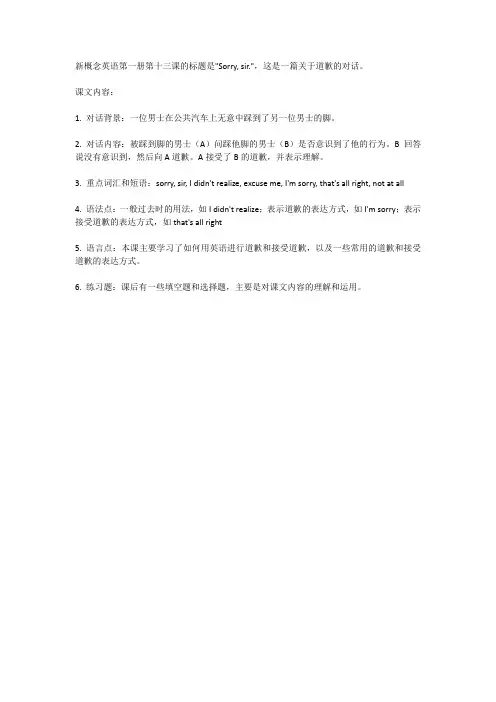
新概念英语第一册第十三课的标题是"Sorry, sir.",这是一篇关于道歉的对话。
课文内容:
1. 对话背景:一位男士在公共汽车上无意中踩到了另一位男士的脚。
2. 对话内容:被踩到脚的男士(A)问踩他脚的男士(B)是否意识到了他的行为。
B回答说没有意识到,然后向A道歉。
A接受了B的道歉,并表示理解。
3. 重点词汇和短语:sorry, sir, I didn't realize, excuse me, I'm sorry, that's all right, not at all
4. 语法点:一般过去时的用法,如I didn't realize;表示道歉的表达方式,如I'm sorry;表示接受道歉的表达方式,如that's all right
5. 语言点:本课主要学习了如何用英语进行道歉和接受道歉,以及一些常用的道歉和接受道歉的表达方式。
6. 练习题:课后有一些填空题和选择题,主要是对课文内容的理解和运用。
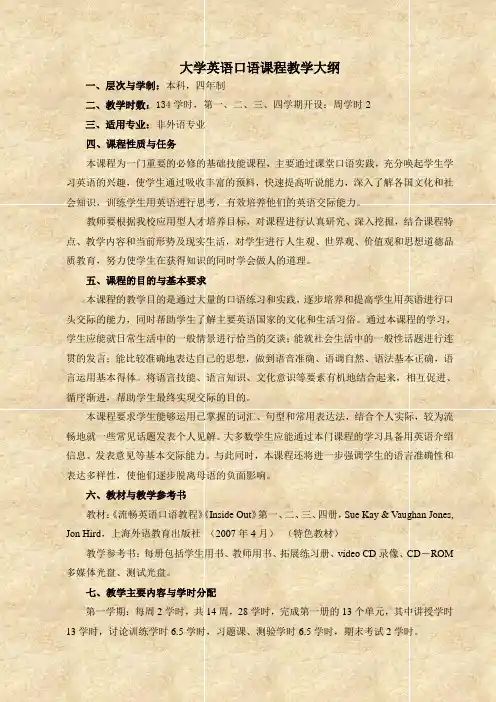
大学英语口语课程教学大纲一、层次与学制:本科,四年制二、教学时数:134学时,第一、二、三、四学期开设;周学时2三、适用专业:非外语专业四、课程性质与任务本课程为一门重要的必修的基础技能课程,主要通过课堂口语实践,充分唤起学生学习英语的兴趣,使学生通过吸收丰富的预料,快速提高听说能力,深入了解各国文化和社会知识,训练学生用英语进行思考,有效培养他们的英语交际能力。
教师要根据我校应用型人才培养目标,对课程进行认真研究、深入挖掘,结合课程特点、教学内容和当前形势及现实生活,对学生进行人生观、世界观、价值观和思想道德品质教育,努力使学生在获得知识的同时学会做人的道理。
五、课程的目的与基本要求本课程的教学目的是通过大量的口语练习和实践,逐步培养和提高学生用英语进行口头交际的能力,同时帮助学生了解主要英语国家的文化和生活习俗。
通过本课程的学习,学生应能就日常生活中的一般情景进行恰当的交谈;能就社会生活中的一般性话题进行连贯的发言;能比较准确地表达自己的思想,做到语音准确、语调自然、语法基本正确,语言运用基本得体。
将语言技能、语言知识、文化意识等要素有机地结合起来,相互促进、循序渐进,帮助学生最终实现交际的目的。
本课程要求学生能够运用已掌握的词汇、句型和常用表达法,结合个人实际,较为流畅地就一些常见话题发表个人见解。
大多数学生应能通过本门课程的学习具备用英语介绍信息、发表意见等基本交际能力。
与此同时,本课程还将进一步强调学生的语言准确性和表达多样性,使他们逐步脱离母语的负面影响。
六、教材与教学参考书教材:《流畅英语口语教程》《Inside Out》第一、二、三、四册,Sue Kay & Vaughan Jones, Jon Hird,上海外语教育出版社(2007年4月)(特色教材)教学参考书:每册包括学生用书、教师用书、拓展练习册、video CD录像、CD-ROM 多媒体光盘、测试光盘。
七、教学主要内容与学时分配第一学期:每周2学时,共14周,28学时,完成第一册的13个单元,其中讲授学时13学时,讨论训练学时6.5学时,习题课、测验学时6.5学时,期末考试2学时。
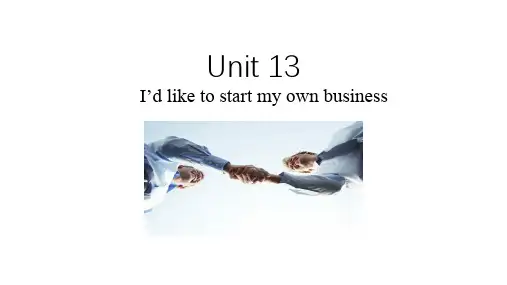
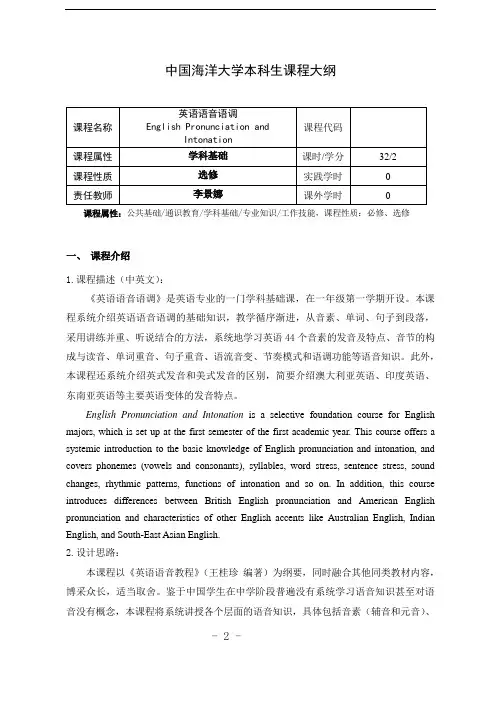
中国海洋大学本科生课程大纲课程属性:公共基础/通识教育/学科基础/专业知识/工作技能,课程性质:必修、选修一、课程介绍1.课程描述(中英文):《英语语音语调》是英语专业的一门学科基础课,在一年级第一学期开设。
本课程系统介绍英语语音语调的基础知识,教学循序渐进,从音素、单词、句子到段落,采用讲练并重、听说结合的方法,系统地学习英语44个音素的发音及特点、音节的构成与读音、单词重音、句子重音、语流音变、节奏模式和语调功能等语音知识。
此外,本课程还系统介绍英式发音和美式发音的区别,简要介绍澳大利亚英语、印度英语、东南亚英语等主要英语变体的发音特点。
English Pronunciation and Intonation is a selective foundation course for English majors, which is set up at the first semester of the first academic year. This course offers a systemic introduction to the basic knowledge of English pronunciation and intonation, and covers phonemes (vowels and consonants), syllables, word stress, sentence stress, sound changes, rhythmic patterns, functions of intonation and so on. In addition, this course introduces differences between British English pronunciation and American English pronunciation and characteristics of other English accents like Australian English, Indian English, and South-East Asian English.2.设计思路:本课程以《英语语音教程》(王桂珍编著)为纲要,同时融合其他同类教材内容,博采众长,适当取舍。
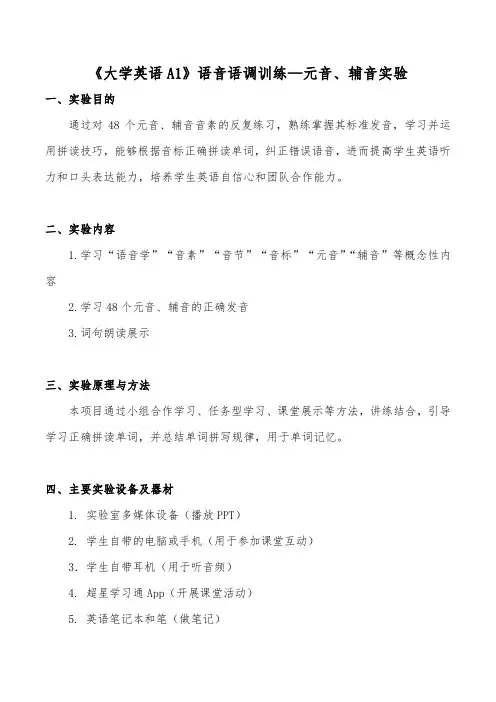
《大学英语A1》语音语调训练—元音、辅音实验一、实验目的通过对48个元音、辅音音素的反复练习,熟练掌握其标准发音,学习并运用拼读技巧,能够根据音标正确拼读单词,纠正错误语音,进而提高学生英语听力和口头表达能力,培养学生英语自信心和团队合作能力。
二、实验内容1.学习“语音学”“音素”“音节”“音标”“元音”“辅音”等概念性内容2.学习48个元音、辅音的正确发音3.词句朗读展示三、实验原理与方法本项目通过小组合作学习、任务型学习、课堂展示等方法,讲练结合,引导学习正确拼读单词,并总结单词拼写规律,用于单词记忆。
四、主要实验设备及器材1. 实验室多媒体设备(播放PPT)2. 学生自带的电脑或手机(用于参加课堂互动)3.学生自带耳机(用于听音频)4. 超星学习通App(开展课堂活动)5. 英语笔记本和笔(做笔记)五、实验步骤1.学生观看视频,老师引出对系统性学习发音和纠正错误发音的重要性讨论。
What is good English pronunciation?Levels:A- Accurate pronunciation and intonation; being native-likeB- No obvious mispronunciation, but not being native-likeC- Marked local accent and occasional mispronunciation which does not cause severe misunderstandingD- Frequent big errors in phonetic or allophonic features, making understanding difficultE- P ronunciation frequently unintelligible2.老师讲解“语音学”“音素”“音节”“音标”“元音”“辅音”等概念性知识,梳理相互之间的关系。
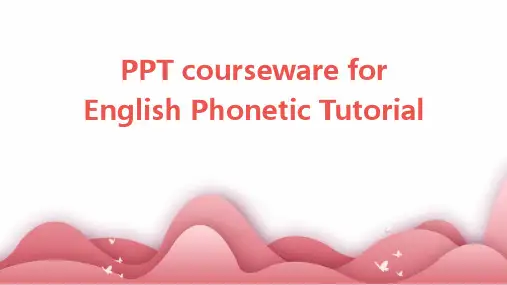
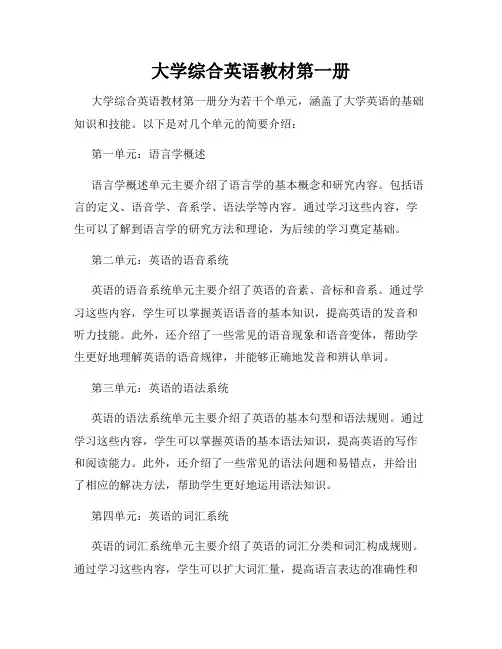
大学综合英语教材第一册大学综合英语教材第一册分为若干个单元,涵盖了大学英语的基础知识和技能。
以下是对几个单元的简要介绍:第一单元:语言学概述语言学概述单元主要介绍了语言学的基本概念和研究内容。
包括语言的定义、语音学、音系学、语法学等内容。
通过学习这些内容,学生可以了解到语言学的研究方法和理论,为后续的学习奠定基础。
第二单元:英语的语音系统英语的语音系统单元主要介绍了英语的音素、音标和音系。
通过学习这些内容,学生可以掌握英语语音的基本知识,提高英语的发音和听力技能。
此外,还介绍了一些常见的语音现象和语音变体,帮助学生更好地理解英语的语音规律,并能够正确地发音和辨认单词。
第三单元:英语的语法系统英语的语法系统单元主要介绍了英语的基本句型和语法规则。
通过学习这些内容,学生可以掌握英语的基本语法知识,提高英语的写作和阅读能力。
此外,还介绍了一些常见的语法问题和易错点,并给出了相应的解决方法,帮助学生更好地运用语法知识。
第四单元:英语的词汇系统英语的词汇系统单元主要介绍了英语的词汇分类和词汇构成规则。
通过学习这些内容,学生可以扩大词汇量,提高语言表达的准确性和丰富性。
同时,还介绍了一些记忆词汇的方法和技巧,帮助学生更好地记忆和运用英语词汇。
第五单元:英语的听力技巧英语的听力技巧单元主要介绍了提高英语听力能力的方法和技巧。
包括如何提高听力注意力、如何预测信息、如何听懂关键词等。
通过学习这些技巧,学生可以在听力考试和实际听力交流中更加流利地理解和应对对话和文章。
第六单元:英语的阅读技巧英语的阅读技巧单元主要介绍了提高英语阅读能力的方法和技巧。
包括如何快速找到关键信息、如何理解上下文、如何推测词义等。
通过学习这些技巧,学生可以在阅读中更加高效地获取信息,提高阅读理解和阅读速度。
第七单元:英语的写作技巧英语的写作技巧单元主要介绍了提高英语写作能力的方法和技巧。
包括如何进行写作计划、如何组织文章结构、如何提高语言表达的准确性和流畅性等。
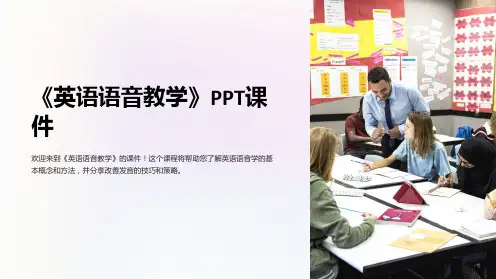
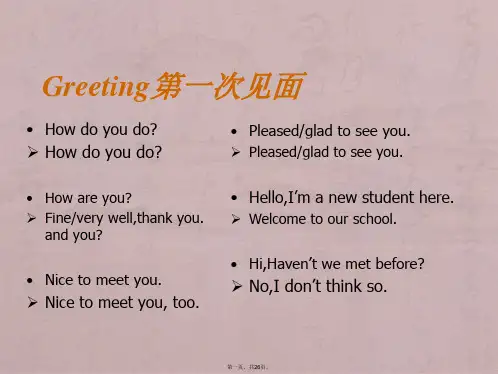
《英语语音》教学大纲一、课程名称:英语语音二、课程类别:专业选修课三、教学时数:周学时数2 ,总学时数20四、学分:2五、开课时间:第二学期六、开课专业:英语专业七、教学对象:英语专业本科一年级学生八、教学目的:英语语音课的目的是向学生系统介绍英语语音和语调的知识,使学生通过学习和练习掌握英语的发音、语流的规律、语调的功能,基本上能正确使用英语语音、语调朗读、表达思想并进行交际。
九、课程内容:本课程要求以学生练习为主,从听辨语音、语调能力的培养入手,将听力、发音与口头表达三方面的训练紧密结合起来,既强调基本功的训练,又注意活用练习。
教学内容要求突出以下几方面:(1) 英语音素的正确发音方法、辨音能力、模仿能力综合训练;(2) 英语的单词重音及语句重音的基本规律、表现形式、表意功能的讲授与训练;(3) 英语语流的节奏规律、基本特征、基本要素、强∕弱读式的训练; (4) 英语所特有的语音、语调的结构、功能及其在交际中的运用。
十、教学时间安排:学期周内容学时第一学期1Pretest, Unit 1 Basic Concepts: Syllables, Stress &Rhythm2 2Unit 2 Consonants: Stops 2 3Unit3 Consonants: Fricatives & Affricates 2 4Unit 4 Consonants: Nasals, Approximants &Lateral(s)2 5Unit 5 V owels: Front V owels & Central V owels 26 Unit6 V owels: Back V owels 27 Unit 7 V owels: Diphthongs 28 Unit 8 Stressed Syllables & Unstressed Syllables 29 Unit 9 Stressed Words & Unstressed Words in a Sentence210 Unit 10 Strong Forms & Weak Forms 211 Unit 11 Linking 212 Unit 12 Rhythm of English Speech 213 Unit 13 Types of Intonation in English 214 Unit 14 Intonation Units of English 215 Unit 15 Functions & Uses of English Intonation 2十一、所用教材:(1)《英语语音教程》王桂珍编著高等教育出版社, 2000(2)《大学一年级英语语音练习手册》张冠林编外语教学与研究出版社, 1988十二、教学参考书目:(1)《国际音标与语音》汪福祥李孚声著外文出版社, 1999(2)《国际音标与语音语调》张卓宏王文广等著清华大学出版社, 2003 (3)Cruttenden, A. Gimson's Pronunciation of English,外语教学与研究出版社,2000(4)Hancock, M. English Pronunciation in Use, Cambridge University Press, 2003(5)Roach, P. English Phonetics and Phonology, Cambridge University Press, 1983.十三、考核方式:学期末考试与平时成绩和课堂表现相结合。
Unit 13 Ethnomedicine (教师用书〕dʒ]❖Listening for general understanding of Tibetan medicine —its working mechanism and current situations.❖Expressing yourselves freely in terms of discussion of Ethnomedicine.❖Making students have a rough idea of evolution of ethnic medicine in China.❖Mastering the precise expressions of branches of ethnic medicine in China.Part I AssimilationTask 1: You will hear four sentences that are already written out for you. Read after the recording, paying attention to the pronunciation of the underlined letters.1) Some therapies were used in Tibetan medicine, such as using butter tea to stopblood, highland barley wine to heal the wounds.[n] to [m] before [m]2) The output value of Tibet's pharmaceutical industry has enjoyed rapid growth in thepast five years.[d] to [g] before [g]3) Traditional Tibetan medicine holds that people get illness because of theenvironment, weather, diet and sleeping, and imbalance of the three factors. [n] to [m] before [m]; [t] to [p] before [p]4) I’m sure you can benefit a lot from those books that I recommen d you to read.[d] + [j] = [dʒ]Notes:In connected speech in English, sounds are often replaced by other sounds under the influence of their neighbors. Sometimes, two neighboring sounds influence each other and are replaced by a third sound which is different from both the original sounds. This kind of pronunciation change is known as assimilation.[ð] to [θ][z] to [s][v] to [f][t] to [p] before [p] , [b], [m][t] to [k] before [k] , [g][d] to [b] before [p] , [b], [m][d] to [g] before [k] , [g][n] to [m] before [p] , [b], [m][n] to [ŋ] before [k] , [g][s] to [ʃ] before [ʃ] , [j][z] to [ʒ] before [ʃ] , [j][d] + [j] = [dʒ][t] + [j] = [tʃ][z] + [j] = [ʒ][s] + [j] = [(t)ʃ]Task 2: You will hear four sentences that are already written out for you. Then mark every case of unstressed words in the sentences.1) The integration of the mental and physical aspects of human body has been developed in Miao medicine.[n] to [m] before [b]2) Those young Mongolian medicine scholars attempt to combine the best practices of Mongolian medicine and western medicine.[z] + [j] = [ʒ]; [n] to [m] before [m]3) The three factors maintain p eople’s seven basic materials.[n] to [m] before [p]4) Some students were sent to study ethnomedicine last year.[t] + [j] = [tʃ]Part Ⅱ Listening TaskTask 1: There are eight sentences related to ethnomedicine.Listen to the following sentences and fill in the blanks with what you have heard.1) Since the ancient times, China has been a multinational country. There are fifty-six ethnic groups live in China now.2) TCM/western integrated medicine attempts to combine the best practices of TCM, western medicine and Chinese medicine of minorities, such as Mongolian medicine and Tibetan medicine.3) Tibetan medicine is a brilliant pearl in the treasury of traditional medicine of China, and has a history more than 2,300 years long.4) Tibetan medicine is similar to traditional Chinese medicine and utilizes herbs, minerals and sometimes insects and animals for treatment.5) Since Four Department of medical had been accomplished, Tibetan medicine gained a totally new period of development.6) Mongolian medicine has been best known for its Lamaist therapy, which is most effective for traumatic surgery and the setting of fractured bones.7) The practitioners of traditional Mongolian medicine want more people to know about the heritage of their healers.8) Miao medicine is an indispensable part of Chinese national medicine, and is the treasure of Miao traditional culture.Task 2: Now you will hear eight short conversations. Listen carefully and choose the best answer to each question from the four choices.1)W: I’ve heard that Mongolia have their own medical system, is that true?M: Yes, in China, different ethnic groups have different medicine.W: Why is this so?M: Because of their distinctive living environments, customs and religions.Question: Which of the following element is not included in the conversation?A) Customs.B) Financial situation.C) Religions.D) Living environments.2) W: Excuse me, Professor Li, would you please tell me what TMM stands for?M: Oh, it refers to traditional Mongolian medicine.W: Why did we westerners know little about it?M: It’s normal, this medical system is rather unknown in the western world, even detailed information can hardly be found in literature.Question: According to the conversation, which of the following is true?A) The woman is a western.B) She knew something about TMM.C) The professor was unable to explain what TMM is for her.D) She can get some information about TMM from western literature.3) W: Hi, Jason, what are you reading?M: It’s about the history of TMM.W: Is it full of ups and downs?M: Absolutely. In the early 20th century, an introduction of Western medicine anda decline of TMM could be observed. However, the revival of TMM in theRepublic of Mongolia in the second half of the last century led to increasing scientific investigations in this ancient medical system in the country. Question: When did TMM revive?A) In the second half of 19th century. B) In the early 20th century.C) In the second half of 20th century. D) In the early 21st century.4) W: When it comes to traditional Chinese medicine, most of us mainly mean thetraditional Han medicine or Kampo.M: Is there anything else?W: Actually, Kampo is the most popular and influential medicine in China.Besides Kampo, there are still many notable Chinese medicine, like Tibetan medicine, Miao medicine and so on.M: Thanks for the tips!Question: What can you know about Kampo?A) It is someon e’s name.B) It refers to traditional Chinese medicine.C) It is another name of Han medicine.D) It represents ethnomedicine in China.5) W: If you want to do some research on Tibetan medicine,Four Department of medical is required to read.M: You mean the most famous Tibetan medicine work compiled by the founder of Tibetan medicine, Yuan Dan Kampot?W: Yes, you are right. It comprehensively summarized Tibetan, Indian and Han medicine, having a far-reaching impact on Tibetan medicine.M: It seems that it’s very necessary to have a look. Thank you for your recommendation.Question: Which of the following is not true about Four Department of medical?A) The author is Yuan Dan Kampot.B) It generalized Tibetan, Han and Indian medicine.C) It is the most famous Tibetan medicine work.D) It is the earliest Tibetan medicine work.6) W: Peter, do you know which one the earliest Tibetan medicine work is?M: It must be Ben Medicine.W: Did it make a great contribution to the development of Tibetan medicine?M: Of course, it mainly introduces the three forms of original Tibetan therapeutic methods—bleed, fire therapy and massage.Question: What are the three forms of original Tibetan therapeutic methods respectively?A) Bleed, fire therapy and moxibustion.B) Bleed, massage and fire therapy.C) Bleed, moxibustion and massage.D) Fire therapy, massage and moxibustion.7) W: Professor Yang, I wonder whether Tibetan medicine is approved by foreignexperts.M: Since the 1980s, the foreign exchanges and co-operation of Tibetan medicine have been increasingly strengthened.W: What detailed measures did we take recently?M: For example, foreign experts and scholars coming to Tibet to research and learn about Tibetan medicine have been increasing every year, accordingly,Tibetan medicine experts have been abroad to hold scientific lectures in adozen of countries.Question: Why did Tibetan medicine experts go abroad?A)They went to go travelling.B)They did some research.C) They learnt about western medicine.D) They held scientific lectures.8) W: I’ve heard that you’ve engaged in advanced studies on Miao medicine forone year. What impressed you most?M: It should be Miao ancestor’s wisdom.W: Does it have any positive impact on Miao medicine?M: Yes, they were good at adapting both the natural and social ecology, which resulted in the unique characteristics of Miao medicine— fresh herbs, Shaman-doctor practice and trauma treatment skills.Question: According to the man, what result in the specialties of Miao medicine?A) Geographic advantage.B) Religious tradition.C) Natural and social ecology.The fundamental principles of Traditional Chinese medicine (TCM) came to Japan between the 7th and 9th centuries. Since then, the Japanese have created their own unique system of diagnosis and therapy. Japanese traditional medicine uses most of the Chinese therapies including acupuncture and moxibustion, but Kampō in its present-day sense is primarily concerned with the study of herbs.Part ⅢSpeaking TaskTask 1: You will hear a passage about theory and methods of treatment in Tibetan medicine. Listening to the recording and answer the following questions according to what you have heard.Traditional Tibetan medicine think there are three major factors lies in human body, they are 〝Long〞(隆) or qi, 〝ChiBa〞(赤巴) or fire , and 〝PeiGen〞(培根) or earth and water. The three factors maintain people’s seven basic materials, subtle diet (饮食精微),blood, meat, fat, bone and marrow, and three kinds of excretions, defecate, urine, and sweat. Long dominates blood, limbs, reproduction, and five senses. ChiBa is about bile, functioning in looking, temperature, and digestion and so on. As for PeiGen that is associated with saliva, handling sleeping, liquid cycle and characters.Traditional Tibetan medicine holds that people get illness because of the environment, weather, diet and sleeping, and imbalance of the three factors. The basic diagnosis of Tibetan is similar to Han medicine that is observation, auscultation and olfaction, interrogation, and pulse feeling. Besides these ways, there is an unique way of Tibetan medicine is the urinary diagnosis〔尿诊〕. There are three steps in the urinary diagnosis: First, gathering the first urine in the morning. Second, putting the urine in a silver bowl and stirring it. Third, diagnosing the disease by observing theQuestions:1. According to traditional Tibetan medicine, what are the three major factors lies inhuman body?Answer: They are 〝Long〞, 〝ChiBa〞and 〝PeiGen〞.2. What do they stand for?Answer:〝Long〞refers to qi, 〝ChiBa〞stands for fire, and 〝PeiGen〞represents earth and water..3. Please generalize the three steps in the urinary diagnosis.Answer: First, gathering the first urine in the morning. Second, putting the urine in a silver bowl and stirring it. Third, diagnosing the disease by observing the color, foam, smell, and floating material, and deposit of the urine.Task 2: Comparison and SpeakingAs we know, to large extent, Tibetan medicine is similar to traditional Chinese medicine. It is cannot be denied that two Tang Dynasty princesses Wen Cheng and Jin❖One student acts as a volunteer in World Medical Conference, and the other act asa foreigner who is eager to know the history of Ethnomedicine in China.❖The volunteer introduces the Ethnomedicine in China to the foreigner, and the foreigner asks some questions, including: the histoy of it, the similarities and differences between the Tibetan medicine and the traditional Chinese medicine. ❖Then students exchange their role and make the conversation.❖At last, one group of students would be invited to give a show on the platform to the whole class.❖You can use the knowledge introduced in the above passage.❖The following useful expressions might be used.Language focus:Here are some useful sentences and structures that you might find handy in finishing the above activity.1. be married to2. in 641 A.D.; King Songzan Gambo3. bring with sb. many Chinese books4. medical books, herbal formulas and medical instruments5. in 710 A.D.; King Chide Zuzain6. bring several Chinese physicians to Tibet7. from that time on8. traveled frequently between … and …9. sent students to Changan10. promote/stimulate/boost the development of …Part IV Leisure TimeEnjoy the video and try to grasp a general understanding about evolution of Tibetan medicine.Now listen to a news report. (截取00:00至01:16)4,000-year old Tibetan medicine— A combination of science and artTraditional Tibetan medicine has a history of 4,000 years. It's characterized by a uniqueness which combines science and art with Tibetan culture. CCTV reporter Mao Xuzhi has more on the mystery of traditional Tibetan medicine.40-year-old Tonzhub is a renowned university professor in the field of Traditional Tibetan medicine. Whenever he has spare time, Tonzhub will go to a nearby hospital to treat patients.Tibetan medicine plays an important role in the Tibetan's daily life. It's regarded as a holistic system, which addresses the needs of the body, mind and spirit.Tonzhub says although Tibetan medicine is based on a different pathology compared with other medical theories, its unique characteristics makes it an inseparable part in today's medical world.Tonzhub said, "Traditional Tibetan medicine is purely natural and unpolluted. It has unique curative effect. I believe Tibetan medicine will play a bigger role in China and the world in the 21 century."Part V Additional TaskYou will hear a short passage about ethnomedicine. After listening, please fill in the blanks.Tibet autonomous region aims to double its pharmaceutical industry's output to 1.3 billion yuan (204 million U.S. dollars) by 2021, local pharmaceutical authorities said Wednesday.Tibet plans to increase the output value of its pharmaceutical industry, dominated by traditional Tibetan medicine, by over 14 percent annually between 2021 and 2021, as stated in the region's pharmaceutical industry development plan issued recently, according to officials with the region's medicine administration.The output value of Tibet's pharmaceutical industry has enjoyed rapid growth in the past five years and reached 650 million yuan in 2021, officials said.Over the next five years, Tibet plans to develop three to five new medicine products with indigenous intellectual property rights and cultivate two or three pharmaceutical companies with annual revenue of 300 million yuan each, they added.Task 2: Oral Practice.It is believed that the on-going combination between Shamans and medicine exert negative impacts on the development of Miao medicine. Would you please talk about your idea about the relationship between theology and medicine?。
《英语语音》课程教学大纲课程编号:ENGL2001课程名称:英语语音(English Pronunciation for Communication)课程类别:专业必修课授课对象:英语专业开课学期:秋季学分:1主讲教师:王宇、陆小明、孟祥春、莫俊华、陆倩、华苏扬等指定教材:王桂珍,《英语语音教程》,高等教育出版社,2005年张冠林,《大学一年级英语语音练习手册》,北京:外语教学与研究出版社,2006年教学目的:语音是英语专业学生必须掌握的一项基本技能,语音语调的好坏会直接影响英语学习者的学习质量和实际交际能力。
掌握准确规范的语音和流畅自然的语调才能在实际交际中正确理解他人要表达的意思,同时也能让别人听清、听懂自己在说什么。
英语语音语调的改善固然需要持之以恒地努力,但是正确的方法必然会使学习者收到事半功倍的效果。
在与英语专业学生的实际接触中,我们发现相当一部分英语专业的学生在入学时对英语语音最基础的内容——元音和辅音的正确发音——的把握不够理想。
从对于英语语音深层次的内容,如单词重音、强读式和弱读式、连读、停顿、句子重音、节奏、语调等的把握情况来看,存在的问题恐怕就更多一些。
英语语音课作为英语专业一年级必修课的主要任务不仅限于传统的语音音素教学,更重要的是突出学好英语语音的根本目的是为了更好地进行语言交际。
因此,在授课过程中,我们首先帮助学生发现自身存在的语音问题,然后通过课堂上的概念讲解、教师示范、听音、辨音和模仿等教学活动与课后练习相结合的方式助其找到解决上述影响正常交际的问题的方法,从而有效提高其英语语音水平以期达到达意、得体地进行跨文化交际的目的。
辅助教材:1.Bradford, Barbara. 1988. Intonation in Context. Cambridge. Cambridge University Press.2.葆菁,《实用英语语音》,北京:高等教育出版社,1994年。